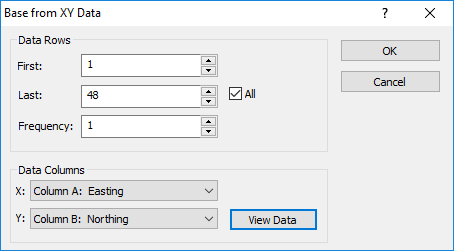Base Map from Data
Click the Home | New Map | Base from Data command or the  button to create a new base map from an XY data file. Click the Home | Add to Map | Layer | Base from Data or Map Tools | Add to Map | Layer | Base from Data to add a base layer from an XY data file to an existing map. Each XY data point in the file is represented by a point object in the base map. Any other column data is added as attributes to the points in the base layer. If the data file includes a header row, the headers will be used for attribute names. The data file must contain at least two rows and two columns of data to create a base map.
button to create a new base map from an XY data file. Click the Home | Add to Map | Layer | Base from Data or Map Tools | Add to Map | Layer | Base from Data to add a base layer from an XY data file to an existing map. Each XY data point in the file is represented by a point object in the base map. Any other column data is added as attributes to the points in the base layer. If the data file includes a header row, the headers will be used for attribute names. The data file must contain at least two rows and two columns of data to create a base map.
The points in the base map can be edited, queried, and geoprocessed with the Features tab commands.
To create a base map from XY data,
- Click the Home | New Map | Base | Base from Data command.
- Select the data file in the Open Data dialog and click Open.
- The Base from XY Data dialog is displayed.
- Specify the rows you wish to include in the base layer and which columns contain the X and Y coordinates.
- Click OK.
Base from Data Layer vs Post Layer
The Base from Data, post, and classed post layer types use XY data files to create map layers. Post and classed post layers are a single object, and therefore post and classed post maps use less memory and are faster to render. Post or classed post maps should be used for large data files. Post and classed post maps have more control over labels and can be included in legends. Base layers include each point as an object. These point objects can be edited and queried after creating the base layer. The points in the base layer also retain attribute information, and therefore a symbology can be applied to the base layer.
Base from XY Data Dialog
The Base from XY Data dialog is displayed when creating a base layer. Specify the rows you wish to include in the base layer and which columns contain the X and Y coordinates in the Base from XY Data dialog.
|
|
|
Specify data rows and columns in the Base from XY Data dialog. |
Data Rows
The Data Rows group controls which rows from the data file are included in the base layer.
First
Specify the first row you wish to include in the base layer in the First field. Type the row number in the First field or click the  buttons to change the value.
buttons to change the value.
Last
Specify the last row you wish to include in the base layer in the Last field. Type the row number in the Last field or click the  buttons to change the value.
buttons to change the value.
Frequency
Specify the number of rows included between the first and last row in the Frequency field. Use the Frequency field to reduce the number of points created from large data files. A Frequency of 1 includes every row. A Frequency of 2 includes every second row after the First row. A Frequency of 3 includes every third row, 4 includes every fourth row, etc. The First row is always included.
For example the Demogrid.dat sample data file includes a header row and 47 rows of XYZ Data. When First is set to 1, Last is set to 48, and Frequency is set to 2, rows 1, 3, 5, 7, ...47 are included in the base map. For Demogrid.dat row 1 is excluded because it is a header and contains text data. When First is set to 2, Last is set to 48, and Frequency is set to 2, rows 2, 4, 6, ...48 are included in the base map.
All
Check the All check box to include all data in the data file in the base map. The First value will change to 1, the Last value will change to the last row containing data, and the Frequency will change to 1 when the All check box is clicked.
Data Columns
The Data Columns group controls which columns are used for the X and Y coordinates when creating the base layer.
X and Y Coordinates
Specify the column containing X coordinates in the X field. Click the current selection and click the desired column in the list to change the value. Only columns containing data will be included in the X list. Specify the column containing Y coordinates in the Y field. Click the current selection and click the desired column in the list to change the value. Only columns containing data will be included in the Y list. If the data file contains a header row, the column names will be included next to the column letter.
View Data
Click View Data to view the data file in a read-only worksheet window. This window is useful if you need to see the data before determining the X and Y columns or what you want to use for First, Last, and Frequency values.
